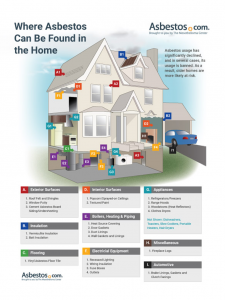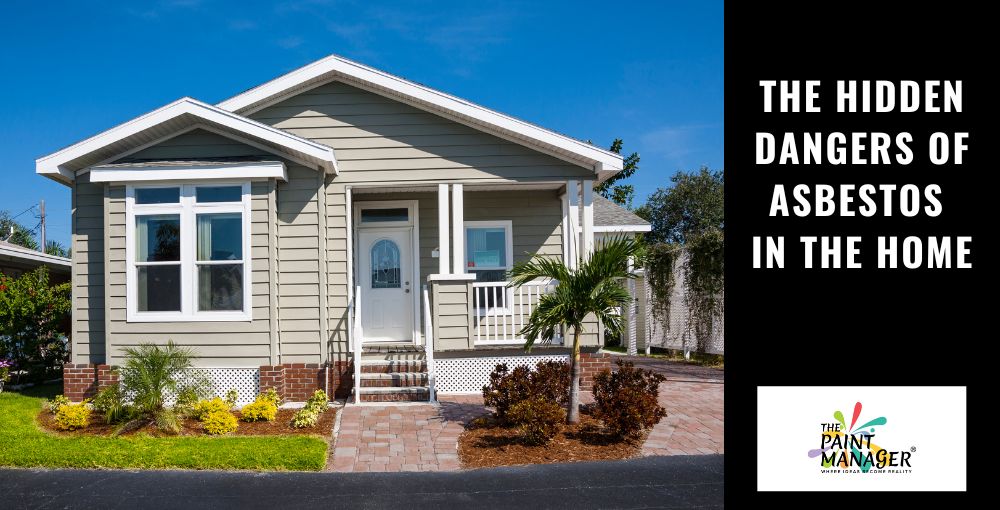Are you planning home improvement projects? If so, you’re probably focusing on the result, looking forward to a smooth ceiling surface instead of that dated popcorn texture – or beautiful hardwood or laminate flooring replacing the old vinyl tile in your “fixer-upper.” Or maybe the upgrade won’t be seen – like new attic insulation that will improve your home’s energy efficiency. However, one thing you’re probably not thinking about is the asbestos that may be hidden in the materials you’ll be removing.
Asbestos is dangerous because it’s a known carcinogen (cancer-causing agent). Inhaling or ingesting it is linked to mesothelioma, asbestosis and other serious health problems. Contrary to popular belief, asbestos use isn’t banned in the United States, although its use is limited. However, asbestos-containing materials still pose a danger because they were common building products in homes, schools and other structures built before the 1980s.
“Homes built before the 1980s could expose homeowners, their families and others to asbestos,” writes Michelle Whitmer, a nationally recognized expert on asbestos who is a writer for The Mesothelioma Center. “It may hide in cement, floor tiles, insulation, walls and pipes. If you’re doing work on your home, like taking down walls or replacing floor tiles, take caution. You could contaminate the air with toxic asbestos fibers.” Diagram courtesy of Asbestos.com®
Diagram courtesy of Asbestos.com®
While you may have heard about asbestos, most people aren’t fully aware of its dangers until they or a loved one receive a diagnosis of an asbestos-related disease such as mesothelioma. The average life expectancy for mesothelioma patients is 12 to 21 months after diagnosis.
Because increasing public awareness of asbestos in the home is so important, we will depart from our usual blog post format this month and feature the valuable information in Whitmer’s article for Asbestos.com. We invite you to read the entire article there, and refer back to the website, which is presented by The Mesothelioma Center.
What is Asbestos?
Asbestos is a naturally occurring fibrous silicate mineral known for its resistance to heat, electricity and corrosion. This led to its use in many products – including insulation, construction materials, brakes and more. Its fibers can be inhaled or ingested, which contributes to the health risks associated with asbestos exposure. Inhaled asbestos fibers become trapped in the body, causing diseases such as mesothelioma, lung cancer and asbestosis.
Old buildings that contain legacy asbestos products pose the greatest risk. When residential construction products made with asbestos are damaged, its thin fibers become airborne, presenting a danger to anyone who inhales them. The following areas are where homeowners doing DIY renovations or improvements are most likely to encounter hidden asbestos:
- Cement asbestos board siding/undersheeting.
- Asbestos roofing felt for shingles.
- Asbestos insulation around steam pipes.
- Some vinyl floor tiles.
- Textured paint.
- Asbestos-containing vermiculite insulation.
Asbestos in Attic Insulation
Vermiculite insulation is a pebble-like product that is usually gray-brown or silver-gold in color. It could be either poured in or blown into attic spaces. This material is light-weight, fire-resistant and odorless, and was widely used as insulation for attics and walls. According to the Environmental Protection Agency (EPA), sizes of vermiculite products range from very fine particles to large pieces nearly an inch long.
The danger comes from vermiculite insulation falling through ceiling cracks, as well as crawling through the attic to store items or do repair work. Of course, replacing this insulation with new poses a major exposure risk.
Vermiculite falls into a category known as “loose-fill” insulation. In her article about asbestos insulation, Whitmer writes, “Loose-fill insulation is designed to be poured onto attic floors or blown into hollow spaces inside walls and other building structures. Fluffy loose-fill asbestos insulation – sometimes made almost entirely of the toxic mineral – is extremely dangerous because even a slight air current can disturb it, sending inhalable asbestos fibers into the air. This product was also known as asbestos attic insulation.”
Asbestos in Popcorn Texture Ceilings
Asbestos was used for popcorn texture ceilings until 1980. However, suppliers continued to sell existing inventories of asbestos-laced material, which means that popcorn ceilings installed as late as the mid-’80s could contain asbestos.
As Whitmer writes, “You can’t tell if a ceiling contains asbestos just from its appearance or age. Testing is the only way to know for sure. While undisturbed asbestos isn’t usually a problem, it’s easy to disturb and release harmful dust. Simply installing hooks or nails in the ceiling, accidentally scraping it during cleaning or killing a bug or kids kicking the ceiling from the top bunk bed can all release asbestos into the air.”
Also, in Central Florida, homes are susceptible to structural damage during hurricane season. A tree crashing through the roof of a home with a popcorn ceiling containing asbestos will release it into the air, after which it will settle on interior items and the floor. This scenario also applies to attic insulation containing asbestos.
Today, popcorn ceilings are not only considered out-of-style, they’re a proven deal-breaker when trying to sell a house that has them. For this reason, many homeowners take the DIY approach to removal – putting themselves and their family at risk if the texture hasn’t first been professionally tested for asbestos by an EPA-certified remediation company and declared safe. Foregoing this important step and just moving forward with removing the popcorn texture yourself is not worth the false economy of saving the costs of testing and professional, safe removal if asbestos is present.
As our blog post – “Should You Replace Your Home’s Popcorn Ceilings with a Smooth Surface?” – points out, forgo the temptation to test your textured ceiling with a DIY kit. These kits allow you to take a sample to mail to a laboratory, with the result sent back to you. However, this method isn’t as accurate as an inspection by a licensed abatement company, and increases your risk of exposure. The typical homeowner does not have the proper protective clothing, equipment or knowledge to perform such a test safely – no matter what the instructions on the DIY test kit may lead you to believe!
Asbestos in Drywall and Plaster Walls
Drywall is a lightweight, gypsum-based wallboard that is typically sold as four-foot by eight-foot sheets ranging in thickness from a quarter inch to five-eighths of an inch. It is also commonly known as sheetrock. Drywall sheets are attached to wall studs side by side to form a wall surface. Drywall tape and joint compound conceal the seams and installation hardware to create a smooth appearance. These are the components most likely to contain asbestos. Drywall boards may contain asbestos, but this is not typical. Asbestos exposure can occur during the installation or repair of these products, or when they become damaged.
As for plaster walls, asbestos often was added to plaster until the mid-1980s. It was an inexpensive way to increase the plaster’s ability to insulate buildings and resist fire.
Once again, undisturbed drywall or plaster walls pose no immediate risk of exposure. Although it’s easy to understand that the demolition performed during remodeling creates a dangerous condition, it’s important to realize that even relatively minor work – such as drilling to install drywall anchors or installing a new thermostat – can send asbestos fibers airborne.
Remodel Wisely to Keep You and Your Family Safe
Unfortunately, there are many other materials in your home that may contain asbestos. Rather than relying on guesswork, wishful thinking or a DIY kit, make the necessary investment in hiring a professional licensed professional asbestos abatement company for detection, removal and disposal. Tim Povtak – senior content writer for Asbestos.com – provides an informative guide on how to hire such a company. The guide also can be downloaded as a pdf for convenient reference.
The Mesothelioma Center at Asbestos.com is based in Orlando, and is the nation’s most trusted mesothelioma resource. Its core purpose is advocacy, awareness and connecting people to the best mesothelioma resources. For more than 15 years, it has built a community of top doctors, hospitals, experts and survivors to help guide patients and their families. Our team at The Paint Manager gratefully thanks this organization for the valuable work it performs.
Once you learn that your home is asbestos-free – or you have the necessary abatement performed – you can start your improvement project(s) confident that your home is safe, and will continue to be your haven for years to come. Or be a safe, beautiful home-sweet-home for its next owner, if you’re planning to sell.
If you’re not the DIY type, our professionals have the experience, skill, equipment and supplies to make sure the job is done correctly and safely. The Paint Manager has been proudly serving Central Florida homeowners for over 20 years with experienced, dedicated and professional services that include exterior and interior house painting, roof repair and cleaning, drywall repair, popcorn ceiling texture removal, cabinet refinishing and so much more!
Plus, become a member of The Paint Manager to receive a 15% year-‘round member’s discount. Contact us to learn more about our services and membership discount offer. We look forward to meeting you!

